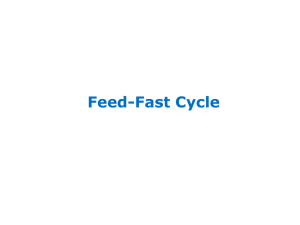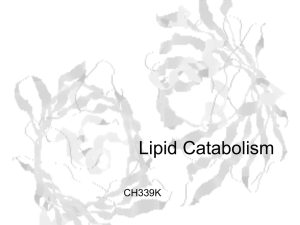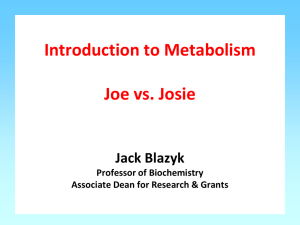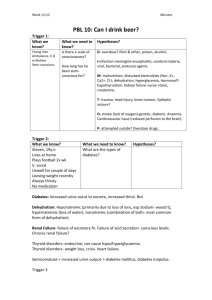Biochemistry Ch. 3 p30-37 [4-20
advertisement
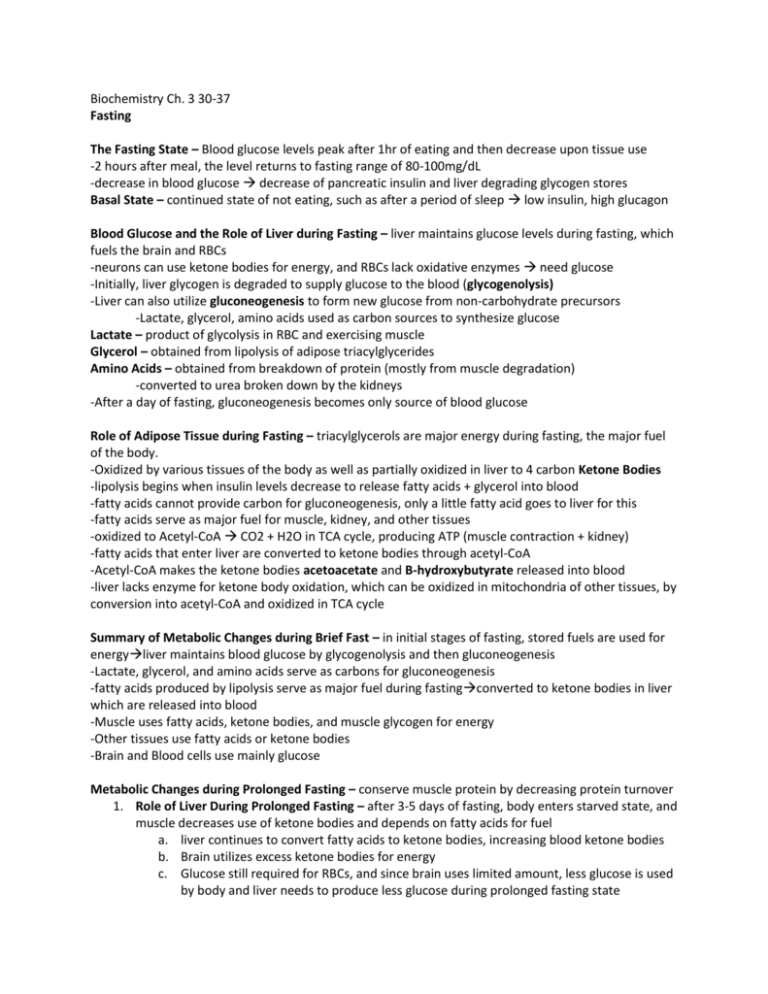
Biochemistry Ch. 3 30-37 Fasting The Fasting State – Blood glucose levels peak after 1hr of eating and then decrease upon tissue use -2 hours after meal, the level returns to fasting range of 80-100mg/dL -decrease in blood glucose decrease of pancreatic insulin and liver degrading glycogen stores Basal State – continued state of not eating, such as after a period of sleep low insulin, high glucagon Blood Glucose and the Role of Liver during Fasting – liver maintains glucose levels during fasting, which fuels the brain and RBCs -neurons can use ketone bodies for energy, and RBCs lack oxidative enzymes need glucose -Initially, liver glycogen is degraded to supply glucose to the blood (glycogenolysis) -Liver can also utilize gluconeogenesis to form new glucose from non-carbohydrate precursors -Lactate, glycerol, amino acids used as carbon sources to synthesize glucose Lactate – product of glycolysis in RBC and exercising muscle Glycerol – obtained from lipolysis of adipose triacylglycerides Amino Acids – obtained from breakdown of protein (mostly from muscle degradation) -converted to urea broken down by the kidneys -After a day of fasting, gluconeogenesis becomes only source of blood glucose Role of Adipose Tissue during Fasting – triacylglycerols are major energy during fasting, the major fuel of the body. -Oxidized by various tissues of the body as well as partially oxidized in liver to 4 carbon Ketone Bodies -lipolysis begins when insulin levels decrease to release fatty acids + glycerol into blood -fatty acids cannot provide carbon for gluconeogenesis, only a little fatty acid goes to liver for this -fatty acids serve as major fuel for muscle, kidney, and other tissues -oxidized to Acetyl-CoA CO2 + H2O in TCA cycle, producing ATP (muscle contraction + kidney) -fatty acids that enter liver are converted to ketone bodies through acetyl-CoA -Acetyl-CoA makes the ketone bodies acetoacetate and B-hydroxybutyrate released into blood -liver lacks enzyme for ketone body oxidation, which can be oxidized in mitochondria of other tissues, by conversion into acetyl-CoA and oxidized in TCA cycle Summary of Metabolic Changes during Brief Fast – in initial stages of fasting, stored fuels are used for energyliver maintains blood glucose by glycogenolysis and then gluconeogenesis -Lactate, glycerol, and amino acids serve as carbons for gluconeogenesis -fatty acids produced by lipolysis serve as major fuel during fastingconverted to ketone bodies in liver which are released into blood -Muscle uses fatty acids, ketone bodies, and muscle glycogen for energy -Other tissues use fatty acids or ketone bodies -Brain and Blood cells use mainly glucose Metabolic Changes during Prolonged Fasting – conserve muscle protein by decreasing protein turnover 1. Role of Liver During Prolonged Fasting – after 3-5 days of fasting, body enters starved state, and muscle decreases use of ketone bodies and depends on fatty acids for fuel a. liver continues to convert fatty acids to ketone bodies, increasing blood ketone bodies b. Brain utilizes excess ketone bodies for energy c. Glucose still required for RBCs, and since brain uses limited amount, less glucose is used by body and liver needs to produce less glucose during prolonged fasting state d. Liver glycogen depleted after 30 hours of fasting, gluconeogenesis is only process that continues amino acid pool from protein breakdown continues to serve as major carbon source as a result of decreased gluconeogenesis, protein is spared decreased urea synthesis 2. Role of Adipose Tissue During Fasting – adipose is continually broken down to fatty acids and glycerol into blood during prolonged fasting to serve as major fuel source a. Glycerol converted to glucose b. Fatty acids oxidized to CO2 and H2O in tissues such as muscle i. In liver, fatty acids converted to ketone bodies and oxidized by tissues like brain -factors that determine how long we can survive during fasting amount of adipose tissue, body protein levels,
